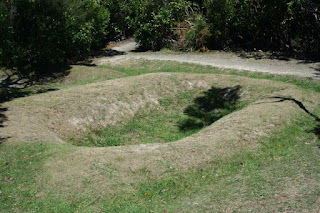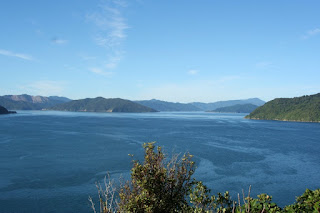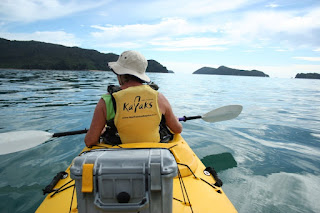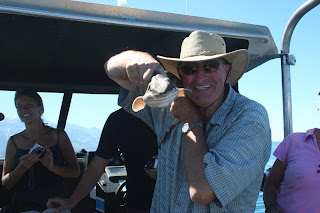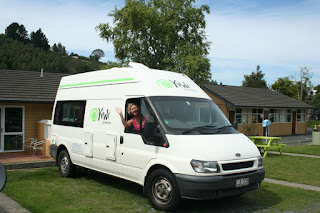Just when you think you have seen the best, most awesome, whatever expression you want to use, New Zealand comes up with another awesome place. Rotorua is such a place, probably not better than some other places but definitely a must see if you ever travel to New Zealand.
Rotorua town and the lake are set in the center of a large volcanic bowl. You can stand on the lookout tower in the museum and see the edges of the crater bowl above the town on all sides. There is a belt through NZ North Island that has 17 thermal zones, including two thermal power plants that contribute five percent of NZ's power. At first I thought the cooling tower of a thermal plant was a nuclear plant and was confused as I did not think NZ had nuclear power. Then I thought maybe thermal which I later was able to confirm. A pretty neat and green way to produce power.
The area is on top of huge geothermal pools and as you drive into and out of the town you can observe spouts of steam coming up from the ground through the fissures into the hot underground water sources.
Originally settled by the Maori, British missionaries moved to the area in 1843 and established a mission which grew to a village in the vicinity of the white and pink terraces. These terraces were formed by thermal water draining down the side of the mountain and solidifying into descending pools deep enough for people to bath in. The white and pink colors came from the type of minerals in the water. Pictures of the two terraces show one a brilliant white and the other a salmon pink. The terraces were proclaimed to be the eight natural wonder of the world.
The local Maori tribe collected great amounts of money from European tourists that led to increased illness and alcoholism amongst them. One of the tribes priest warned of coming disaster and around June 1st 1885 a group of tourists and their Maori guide seen a ghost canoe of Maori on the lake leading to the terraces. Ten days later Tarawera Mountain erupted and the flow of basalt magna and mud completely buried two Moria villages, destroyed the British settlement and buried the white and pink terraces forever.
Even after this tragedy people continued to move into the Rotorua area and make use of the thermal water for medicinal and bathing purposes. As early as 1878 people with arthritis were brought to the area for immersion in the waters. One of the pools later became known as the "Priest Pool" after a Catholic priest, disabled with arthritis, who was able to walk home to his Parrish after treatment in the pool. Successive baths were built in the area and two bath houses remain, the Blue Baths and the Bath House. The Blue Baths built in the 1930s house swimming pools and event rooms for weddings etc.
The Bath House was built in the early 1900s as a sanatarium and health spa to use the hot mineral waters. The bath house was used to treat various ailments including arthritis, rheumatism, nervous disorders, psoriasis. The spas were also used as a rehabilitative hospital for wounded soldiers returning from World War II. Due to the high acidic content of the waters maintenance was and costly and the medicinal effects of the waters was called into question by health authorities, the money generated by the tourist trade was not able to keep the Bath House maintained.
The Bath House has been restored and now houses the Rotorua Museum. The museum houses and tells the story of the Bath House, Maori settlement and culture of the area and the Maori Battalion that fought with distinction and high losses during World War II.
 |
| Museum, formerly the Bath House |
The Battalion was formed by the Maori themselves and all that joined were volunteers. Many families saw all their sons join, some as young as 16. They fought in Greece, with great defeat and then were shipped to Africa, where faced with charging a German line, one of them led the way with a Maori battle song. They won the line and and with continued reinforcement from the Maori back home fought with distinction in North Africa and Italy. The losses were extremely high, one in six were lost, and many of the interviewees expressed that some of the problems that the Maoris have experienced with later generations are the result of that group of men not being there to guide the younger generations.
The next day we visited the thermal wonderland of Wai-O-Tapu, (Sacred Waters in English), a very diverse and beautiful area of thermal activity. A three kilometer walk takes you through hot springs, hot pools, newly formed terraces and other thermal activity. Wai-O-Tapu sits on the edge of a volcanic caldera.
First on the agenda was Lady Knox Geyser, which with some help erupts every morning at 10:15. Without help, the Lady erupts between twelve and seventy hours. Under the geyser is cold water over laying extremely hot, 100 degree celsius, water that eventually heats up the surface tension of the cold water level, which then beaks and allows the hot water and steam to erupt. The geyser was originally discovered by penitentiary inmates on a tree planting work gang. Deciding to wash their clothes they used carbolic soap in the hot pool and the soapy water draining underground broke the surface tension causing the geyser to erupt. Today for the show they dump down a bit of surficant and within about 5 minutes Lady Knox explodes, up to twenty meters in height and can last for twenty minutes. Over time the silica in the water has hardened and formed the mound that they drop the surficant down.
 |
| Geezer at the Geyser |
The walk itself wanders around and through the thermal pools and cavities that have fallen in from the erosion of the fissure walls from corrosive and acidic waters. Many of the pools are filled with colored water from all the different minerals contained in the water.
Colors run from rust through shades of yellow and green.
Also forming is another smaller set of terraces from the spill of the biggest pool. It was a very informative and mind opening walk which you can tell, I was quite taken with! We also went to see the boiling mud pools.
Then off to a Maori village for a cultural show. There are many hotels in Rotorua that have Maori shows and two family villages where they put on a cultural show and treat you to a "hangi" traditionally cooked meal. The one family village belongs to a family that as young men they ran afoul of the law a lot. The brothers decided to reform and built a thriving business around the village and performing for the public. Seven shows a week that are usually sold out.
The Maori cooked all their food in ground pits. First they build a fire of wood and then line the embers with river rock, when the rock is white hot in goes the food wrapped in wet leaves and matting. Then they cover all with dirt and let steam for a couple of hours, then they dig it out and consume. I remember my Dad cooking a side of beef for a community picnic similar to this on the sand flats at East Pine when I was a kid.
They are a little more modern as the fire is propane fired and the the food is all put into big steel pans and then covered with moist cloths and steel oven lids. Nor was the food traditional as it was lamb, chicken, potatoes, kumara and lots of salads. Kumara, red sweet potato, was the only traditional Maori food of the evening, but it still was yummy good.
The warriors greeted us by paddling a war canoe down a small stream that transects their family lands. All had facial tattoos and performed wonders with the canoe, paddling forward, backwards and side ways across the creek at will.
Next we went into the village to be greeted by the Chief and welcomed to their world. There were 10 male performers and 4 ladies, yes the ladies also had facial tattoos.
All Maori tattoo patterns tell a story, lineage, deeds, etc., and for Maori of different tribes or non-Maori to copy them is insulting. To stop copying of their tattoos, the Maori have developed tattoo patterns based on Maori lore that have no tribal or mythical Maori meaning. These are the ones that are sold in the tattoo shops. Loreen threatened to throw a hussy fit when I wanted to get a warrior tattoo over my right eye. Not sure why she got so excited. I thought one similar to this would look nice!
 |
| I liked the tat on the middle guy |
They performed a number of dances, songs and demonstrated the use of their weapons. A lot of the dances performed were built around a warrior society and developed as way to exercise muscles and joints to handle weapons. Dances at the performance last minutes but in fighting times would last up to 30 or 40 minutes at a time for strengthening and building flexibility. Lastly they performed the tribal "haka" war dance where they bulge out the eyes, stick out the tongue and generally scare the hell out of you if you had to face them in a battle. The chief explained a lot of their myths and how the Maori formed the two islands of New Zealand.
 |
| Haka |
Then off to the "hangi" where we feasted and drank wine - imagine that, Loreen and I drinking wine! All in all a very pleasant and entertaining evening. We are off from Rotorua in the morning for our next big adventure, me driving through Auckland, city of 1.2 million, looking for traffic signs and going through three and four lane traffic circles. Woo hoo!














